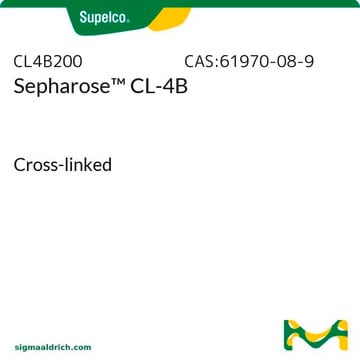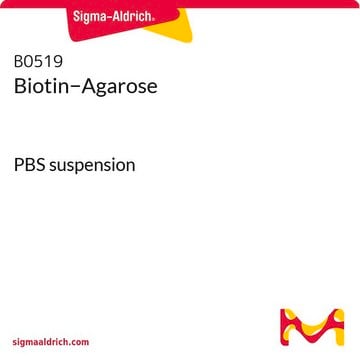GE17-0120-01
Sepharose™ 4B
Cytiva 17-0120-01, pack of 1 L
About This Item
Recommended Products
packaging
pack of 1 L
manufacturer/tradename
Cytiva 17-0120-01
matrix
4% agarose
particle size
45-165 μm
cleaning in place
4-9
working range
4-9
InChI
1S/C24H38O19/c25-1-5-9(27)11(29)12(30)22(38-5)41-17-8-4-36-20(17)15(33)24(40-8)43-18-10(28)6(2-26)39-23(14(18)32)42-16-7-3-35-19(16)13(31)21(34)37-7/h5-34H,1-4H2/t5-,6-,7+,8+,9+,10+,11+,12-,13+,14-,15+,16-,17-,18+,19+,20+,21-,22+,23+,24+/m1/s1
InChI key
MJQHZNBUODTQTK-WKGBVCLCSA-N
Looking for similar products? Visit Product Comparison Guide
Related Categories
General description
Application
Sepharose™ CL gels are cross-linked derivatives of Sepharose™ 2B, Sepharose™ 4B and Sepharose™ 6B. The cross-linked form of Sepharose™ is chemically and physically more resistant than Sepharose™ itself, offering the same selectivity with better flow characteristics. Cross-linked Sepharose™ gels are resistant to organic solvents and are thus the choice for separations in organic solvents
Features and Benefits
- 4% Agarose gel filtration media.
- Proven base matrix for coupling affinity ligands
Storage and Stability
Analysis Note
Legal Information
Signal Word
Warning
Hazard Statements
Precautionary Statements
Storage Class Code
3 - Flammable liquids
Certificates of Analysis (COA)
Search for Certificates of Analysis (COA) by entering the products Lot/Batch Number. Lot and Batch Numbers can be found on a product’s label following the words ‘Lot’ or ‘Batch’.
Already Own This Product?
Find documentation for the products that you have recently purchased in the Document Library.
Customers Also Viewed
Our team of scientists has experience in all areas of research including Life Science, Material Science, Chemical Synthesis, Chromatography, Analytical and many others.
Contact Technical Service












